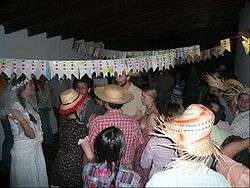Festa Junina

Festa Junina (Portuguese pronunciation: [ˈfɛstɐ ʒuˈnĩnɐ], June Festival), also known as festa de São João for their part in celebrating the nativity of St. John the Baptist, are the annual Brazilian celebrations historically related to European Midsummer that take place in the beginning of the Brazilian winter. These festivities, which were introduced by the Portuguese during the colonial period (1500-1822), are celebrated during the month of June nationwide both in Brazil and Portugal. The feast is mainly celebrated on the eves of the Catholic solemnities of Saint Anthony, Saint John the Baptist, and Saint Peter.
As Northeastern Brazil is largely arid or semi-arid these popular festivals not only coincide with the end of the rainy seasons of most states in the northeast but they also provide the people with an opportunity to give thanks to Saint John for the rain. They also celebrate rural life and feature typical clothing, food, dance (particularly quadrilha, which is similar to square dancing). Like Midsummer and Saint John's Day in Portugal and Scandinavian countries, São João celebrates marital union. The "quadrilha" features couple formations around a mock wedding whose bride and groom are the central attraction of the dancing.

The celebrations usually take place in an arraial, a huge tent made of raw material (with a thatched roof) that was reserved for special parties in old rural areas. Men dress up as farm boys with large straw hats and women wear pigtails, freckles, painted gap teeth and red-checkered dresses, all in a loving tribute to the origins of Brazilian country music, and of themselves, some of whom are recent immigrants from the countryside to cities such as Olinda, Recife, Maceió and Salvador, and some of whom return to the rural areas during that season to visit family. However, nowadays, São João festivities are extremely popular in all urban areas and among all social classes. In the Northeast, they are as popular as Carnival. Like during Carnival, these festivities involve costume-wearing (in this case, peasant costumes), dancing, drinking, and visual spectacles (fireworks display and folk dancing). Like the original European Midsummer celebrations, during the two-week June festivities in Brazil, bonfires are lit. They can be seen everywhere in northeastern cities. Two northeastern towns in particular have competed with each other for the title of "Biggest São João Festival in the World", namely Caruaru (in the state of Pernambuco), and Campina Grande,in Paraíba state. In fact, Caruaru features in the Guinness Book of World Records for holding the biggest outdoor country festival.
In the Southeastern states of São Paulo and Minas Gerais as well as the Southern states of Paraná, Santa Catarina and Rio Grande do Sul, the Lusitanian celebrations of Saint Anthony, Saint John and Saint Peter underwent a fusion with the practices of other European countries during St John's Eve or the European Festival of Midsummer's Eve thanks to the European descendants of different nations merging their traditions. The Caipira style of quadrilha or square dancing is typical of the region and danced to country music by couples made of children but also adults usually attending a mock wedding held as a symbol of fertility of the land just like the ones held in Portugal, Norway and Sweden. Nowadays the festival resembles the origins of Pagan Midsummer festivities due the focus on rural life, agriculture, large bonfires and the praise of hinterland dishes displayed in the arraial or feira, the mocking of an ancient European country fair. The word caipira is also the name of the regional dialect or accent and prosody from the Western countryside of the state of São Paulo, north of Paraná, south of Minas Gerais, as well as Goiás and Mato Grosso do Sul in the Center West, where "arraial com quadrilha caipira" can also be seen.